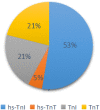Clinical characteristics of COVID-19 with cardiac injury: a systematic review and meta-analysis
- PMID: 33092664
- PMCID: PMC7653493
- DOI: 10.1017/S0950268820002587
Clinical characteristics of COVID-19 with cardiac injury: a systematic review and meta-analysis
Abstract
Objectives: Cardiac injury is associated with poor prognosis of 2019 novel coronavirus disease 2019 (COVID-19), but the risk factors for cardiac injury have not been fully studied. In this study, we carried out a systematic analysis of clinical characteristics in COVID-19 patients to determine potential risk factors for cardiac injury complicated COVID-19 virus infection.
Methods: We systematically searched relevant literature published in Pubmed, Embase, Europe PMC, CNKI and other databases. All statistical analyses were performed using STATA 16.0.
Results: We analysed 5726 confirmed cases from 17 studies. The results indicated that compared with non-cardiac-injured patients, patients with cardiac injury are older, with a greater proportion of male patients, with higher possibilities of existing comorbidities, with higher risks of clinical complications, need for mechanical ventilation, ICU transfer and mortality. Moreover, C-reactive protein, procalcitonin, D-dimer, NT-proBNP and blood creatinine in patients with cardiac injury are also higher while lymphocyte counts and platelet counts decreased. However, we fortuitously found that patients with cardiac injury did not present higher clinical specificity for chest distress (P = 0.304), chest pain (P = 0.334), palpitations (P = 0.793) and smoking (P = 0.234). Similarly, the risk of concomitant arrhythmia (P = 0.103) did not increase observably either.
Conclusion: Age, male gender and comorbidities are risk factors for cardiac injury complicated COVID-19 infection. Such patients are susceptible to complications and usually have abnormal results of laboratory tests, leading to poor outcomes. Contrary to common cardiac diseases, cardiac injury complicated COVID-19 infection did not significantly induce chest distress, chest pain, palpitations or arrhythmias. Our study indicates that early prevention should be applied to COVID-19 patients with cardiac injury to reduce adverse outcomes.
Keywords: COVID-19; Cardiac injury; coronavirus; meta analysis.
Conflict of interest statement
None.
Figures






















References
-
- World Health Organization. Coronavirus disease 2019 (COVID-19): situation reports. 2 May 2020. Available at https://www.who.int/emergencies/diseases/novel-coronavirus-2019/situatio....
-
- Wu Z et al. (2020) Characteristics of and important lessons from the coronavirus disease 2019 (COVID-19) outbreak in China: summary of a report of 72 314 cases from the Chinese Center for Disease Control and Prevention. Journal of American Medical Association 323(13), 1239–1242. doi: 10.1001/jama.2020.2648. - DOI - PubMed
Publication types
MeSH terms
LinkOut - more resources
Full Text Sources
Medical
Research Materials

